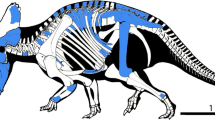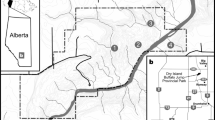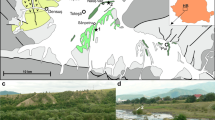Abstract
A new taxon of chasmosaurine ceratopsid demonstrates unexpected disparity in parietosquamosal frill shape among ceratopsid dinosaurs early in their evolutionary radiation. The new taxon is described based on two apomorphic squamosals collected from approximately time equivalent (approximately 77 million years old) sections of the upper Judith River Formation, Montana, and the lower Dinosaur Park Formation of Dinosaur Provincial Park, Alberta. It is referred to Chasmosaurinae based on the inferred elongate morphology. The typical chasmosaurine squamosal forms an obtuse triangle in dorsal view that tapers towards the posterolateral corner of the frill. In the dorsal view of the new taxon, the lateral margin of the squamosal is hatchet-shaped with the posterior portion modified into a constricted narrow bar that would have supported the lateral margin of a robust parietal. The new taxon represents the oldest chasmosaurine from Canada, and the first pre-Maastrichtian ceratopsid to have been collected on both sides of the Canada–US border, with a minimum north–south range of 380 km. This squamosal morphology would have given the frill of the new taxon a unique dorsal profile that represents evolutionary experimentation in frill signalling near the origin of chasmosaurine ceratopsids and reinforces biogeographic differences between northern and southern faunal provinces in the Campanian of North America.




Similar content being viewed by others
References
Dodson P (1993) Comparative craniology of the Ceratopsia. Am J Sci 293-A:200–234
Dodson P, Forster CA, Sampson SD (2004) Ceratopsidae. In: Weishampel DB, Dodson P, Osmólska H (eds) The Dinosauria, 2nd edn. University of California Press, Berkeley, pp 494–513
Eberth DA (2005) The geology. In: Currie PJ, Koppelhus EB (eds) Dinosaur Dinosaur Provincial Park: a spectacular ancient ecosystem revealed. Indiana University Press, Bloomington, pp 54–82
Eberth DA, Hamblin AP (1993) Tectonic, stratigraphic, and sedimentologic significance of a regional disconformity in the upper Judith River Group (Belly River wedge) of southern Alberta, Saskatchewan, and northern Montana. Can J Earth Sci 30:174–200. doi:10.1139/e93-016
Farke AA (2013) Horned dinosaurs from the southern part of the Western Interior Basin of North America. In: Ryan MJ, Williams S (eds) The end of the dinosaurs: changes in the Late Cretaceous biosphere symposium. Burpee Museum of Natural History, Rockford, IL, p 28
Fiorillo AR, Tykoski RS (2012) A new Maastrichtian species of the centrosaurine ceratopsid Pachyrhinosaurus from the North Slope of Alaska. Acta Palaeontol Pol 57:561–573. doi:10.4202/app.2011.0033
Godfrey SJ, Holmes R (1995) Cranial morphology and systematics of Chasmosaurus (Dinosauria: Ceratopsidae) from the Upper Cretaceous of western Canada. J Vertebr Paleontol 15:726–742. doi:10.1080/02724634.1995.10011258
Holmes RB, Forster CA, Ryan MJ, Shepherd KM (2001) A new species of Chasmosaurus (Dinosauria: Ceratopsia) from the Dinosaur Park Formation of southern Alberta. Can J Earth Sci 38:1423–1438. doi:10.1139/e01-036
Horner JR, Goodwin MB (2009) Extreme cranial ontogeny in the Upper Cretaceous dinosaur Pachycephalosaurus. PLoS One 4:1–11. doi:10.1371/journal.pone.0007626
Lambe LM (1915) On Eoceratops canadensis, gen. nov., with remarks on other genera of Cretaceous horned dinosaurs. Bull Can Geol Surv, Geol Series 24, 49 pp
Lehman TM (1987) Late Maastrichtian paleoenvironments and dinosaur biogeography in the western interior of North America. Palaeogeogr Palaeoclimatol Palaeoecol 60:189–217
Lehman TM (1997) Late Campanian dinosaur biogeography in the western interior of North America. In: Wolberg DL, Stump E, Rosenburg GD (eds) Dinofest international: proceedings of a symposium held at Arizona State University. Academy of Natural Sciences, Philadelphia, pp 223–240
Loewen MA, Sampson SD, Lund EK, Farke AA, Aguillón-Martínez MC, de Leon CA, Rodríguez-de la Rosa RA, Getty MA, Eberth DA (2010) Horned dinosaurs (Ornithischia: Ceratopsidae) from the Upper Cretaceous (Campanian) Cerro del Pueblo Formation, Coahuila, Mexico. In: Ryan MJ, Chinnery-Allgeier BJ, Eberth DA (eds) New perspectives on horned dinosaurs: the Royal Tyrrell Museum Ceratopsian symposium. Indiana University Press, Bloomington, pp 99–116
Loewen MA, Farke AA, Sampson SD, Getty MA, Lund EK, O’Connor PM (2013) Ceratopsid dinosaurs from the Grand Staircase of southern Utah. In: Titus AL, Loewen MA (eds) At the top of the Grand Staircase: the Late Cretaceous of Southern Utah. Indiana University Press, Bloomington, pp 488–503
Longrich NR (2013) Judiceratops tigris, a new horned dinosaur from the Middle Campanian Judith River Formation of Montana. Bull Peabody Mus Nat Hist 54:51–65. doi:10.3374/014.054.0103
Maiorino L, Farke AA, Piras P, Ryan MJ, Terris KM, Kotsakis T (2013) The evolution of squamosal shape in ceratopsid dinosaurs (Dinosauria, Ornithischia). J Vertebr Paleontol 33:1385–1393. doi:10.1080/02724634.2013.779922
Mallon JC, Holmes R, Eberth DA, Ryan MJ, Anderson JS (2011) Variation in the skull of Anchiceratops (Dinosauria, Ceratopsidae) from the Horseshoe Canyon Formation (Upper Cretaceous) of Alberta. J Vertebr Paleontol 31:1047–1071. doi:10.1080/02724634.2011.601484
Mallon JC, Evans DC, Ryan MJ, Anderson JA (2012) Biostratigraphy of the megaherbivorous dinosaurs from the Dinosaur Park Formation (upper Campanian) of Alberta, Canada. Palaeogeogr Palaeoclimatol Palaeoecol 350–352:124–138. doi:10.1016/j.palaeo.2012.06.024
Marsh OC (1888) A new family of horned dinosaurs from the Cretaceous. Am J Sci 36:477–478
Marsh OC (1890) Additional characters of the Ceratopsidae, with notice of new Cretaceous dinosaurs. Am J Sci 39:418–426
Rega E, Holmes R, Tirabasso A (2010) Habitual locomotor behavior inferred from manual pathology in two Late Cretaceous chasmosaurine ceratopsid dinosaurs, Chasmosaurus irvinensis (CMN 41357) and Chasmosaurus belli (ROM 843). In: Ryan MJ, Chinnery-Allgeier BJ, Eberth DA (eds) New perspectives on horned dinosaurs: the Royal Tyrrell Museum Ceratopsian symposium. Indiana University Press, Bloomington, pp 340–354
Rogers RR, Kidwell SM (2000) Associations of vertebrate skeletal concentrations and discontinuity surfaces in terrestrial and shallow marine records: a test in the Cretaceous of Montana. J Geol 108:131–154. doi:10.1086/314399
Ryan MJ (2007) A new basal centrosaurine ceratopsid from the Oldman Formation, southeastern Alberta. J Paleontol 81:376–396. doi:10.1666/0022-3360(2007)81[376:ANBCCF]2.0.CO;2
Ryan MJ (2013) The diversity and evolution of horned dinosaurs from the Northern Western Interior Basin of North America. In: Ryan MJ, Williams S (eds) The end of the dinosaurs: changes in the Late Cretaceous biosphere symposium. Burpee Museum of Natural History, Rockford, pp 43–44
Ryan MJ, Evans DC (2005) Ornithischian dinosaurs. In: Currie PJ, Koppelhus EB (eds) Dinosaur Provincial Park: a spectacular ancient ecosystem revealed. Indiana University Press, Bloomington, pp 312–348
Ryan MJ, Russell AP, Hartman S (2010) A new chasmosaurine ceratopsid from the Judith River Formation, Montana. In: Ryan MJ, Chinnery-Allgeier BJ, Eberth DA (eds) New perspectives on horned dinosaurs: the Royal Tyrrell Museum Ceratopsian symposium. Indiana University Press, Bloomington, pp 181–188
Sampson SD, Loewen MA (2010) Unraveling a radiation: a review of the diversity, stratigraphic distribution, biogeography, and evolution of horned dinosaurs (Ornithischia: Ceratopsidae). In: Ryan MJ, Chinnery-Allgeier BJ, Eberth DA (eds) New perspectives on horned dinosaurs: the Royal Tyrrell Museum Ceratopsian symposium. Indiana University Press, Bloomington, pp 405–427
Sampson SD, Ryan MJ, Tanke DH (1997) Craniofacial ontogeny in centrosaurine dinosaurs (Ornithischia: Ceratopsidae): taxonomic and behavioural implications. Zool J Linnean Soc Lond 121:293–337. doi:10.1111/j.1096-3642.1997.tb00340.x
Sampson SD, Loewen MA, Farke AA, Roberts EM, Forster CA (2010) New horned dinosaurs from Utah provide evidence for intracontinental dinosaur endemism. PLoS One 5(9):e12292. doi:10.1371/journal.pone.0012292
Sampson SD, Lund EK, Loewen MA, Farke AA, Clayton KE (2013) A remarkable short-snouted horned dinosaur from the Late Cretaceous (Late Campanian) of southern Laramidia. Proc R Soc B 280:20131186
Scannella JB, Horner JR (2010) Torosaurus Marsh, 1891, is Triceratops, Marsh, 1889 (Ceratopsidae: Chasmosaurinae): synonymy through ontogeny. J Vertebr Paleontol 30:1157–1168. doi:10.1080/02724634.2010.483632
Seeley HG (1888) The classification of the Dinosauria. Rept Br Assoc Adv Sci 1887:698–699
Sereno PC (1986) Phylogeny of the bird-hipped dinosaurs (Order Ornithischia). Natl Geogr Res 2:234–256
Sullivan R, Lucas S (2010) A new chasmosaurine (Ceratopsidae, Dinosauria) from the Upper Cretaceous Ojo Alamo Formation (Naashoibito Member), San Juan Basin, New Mexico. In: Ryan MJ, Chinnery-Allgeier BJ, Eberth DA (eds) New perspectives on horned dinosaurs: the Royal Tyrrell Museum Ceratopsian symposium. Indiana University Press, Bloomington, pp 169–180
Tanke DH, Farke AA (2007) Bone resorption, bone lesions, and extra cranial fenestrae in ceratopsid dinosaurs: a preliminary assessment. In: Carpenter K (ed) Horns and beaks: Ceratopsian and Ornithopod dinosaurs. Indiana University Press, Bloomington, pp 319–347
Tanke DH, Rothschild BM (2010) Paleopathologies in Albertan ceratopsids and their behavioral significance. In: Ryan MJ, Chinnery-Allgeier BJ, Eberth DA (eds) New perspectives on horned dinosaurs: the Royal Tyrrell Museum Ceratopsian symposium. Indiana University Press, Bloomington, pp 355–384
Acknowledgments
The specimen was acquired by the ROM from Triebold Paleontology and prepared by Ian Morrison. UALVP 54559 was discovered by Susan Owen-Kagen on July 1, 2012, collected by SO-K and PJC on July 3, 2012 and subsequently prepared by SO-K. Danielle Dufault drew the line illustrations in Figs. 2 and 4. Clive Coy photographed UALVP 54559. DCE was supported by a Natural Sciences and Engineering Research Council of Canada Discovery Grant. Reviews by Rob Holmes and two anonymous reviewers improved the manuscript.
Conflict of interest
The authors declare that they have no conflict of interest.
Author information
Authors and Affiliations
Corresponding author
Additional information
Communicated by: Robert R. Reisz
Rights and permissions
About this article
Cite this article
Ryan, M.J., Evans, D.C., Currie, P.J. et al. A new chasmosaurine from northern Laramidia expands frill disparity in ceratopsid dinosaurs. Naturwissenschaften 101, 505–512 (2014). https://doi.org/10.1007/s00114-014-1183-1
Received:
Revised:
Accepted:
Published:
Issue Date:
DOI: https://doi.org/10.1007/s00114-014-1183-1




